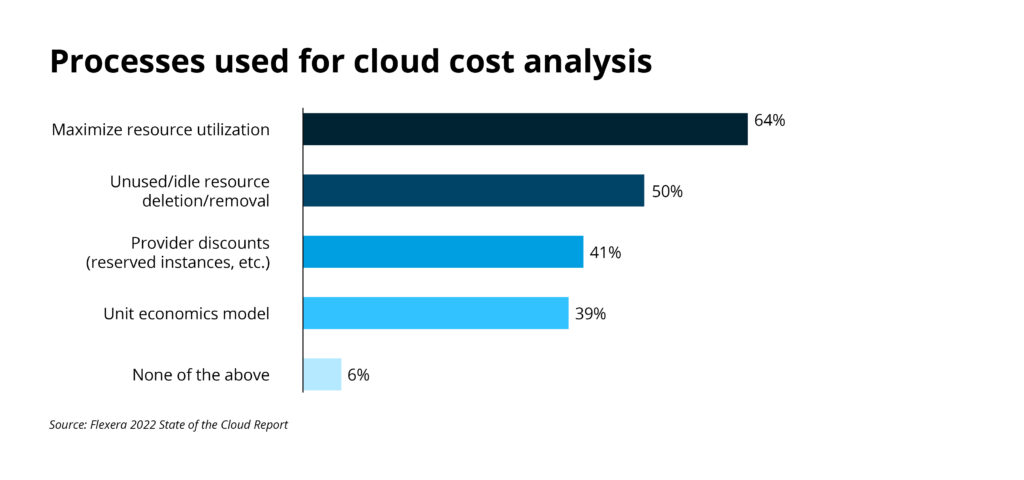In Flexera’s State of the Cloud Report, they state that only 6% of companies they polled have no processes in place for commonly adopted cloud cost analysis, yet they estimate that at least 32% of total cloud spend is wasted. That means even if you have provisioned software or stood up a FinOps team, there is likely a lot of cloud savings still left on the table.

The conversation around saving money on your cloud spend usually revolves around the health of your bottom line. It is true that a well-optimized cloud bill reduces your operating costs and can strengthen your bottom line but there is more at stake than just the cash savings your FinOps team may capture.
If cloud computing and storage is central to your business, its effects on the health of your business are drastic and cannot be understated.
I have been thinking about what else may be affected by runaway cloud costs and here are a few things to consider.
Save Employees from Layoffs
The month of May saw more tech layoffs than the previous four months combined. It should not come as a surprise with the potential impending financial crisis and the uncertainty that brings forth major changes from the top.
An unfortunate casualty of economic turmoil is always too many people losing their jobs. It is an all–too–familiar solution for those who stare at the company’s bottom line, but one line item to consider shrinking should be cloud expenditure.
No one wants to be on the list of layoffs, and high-level executives do not want to have to resort to reducing their workforce, but it remains the go-to option when the bottom line needs savings. Many top-level executives who are responsible for laying off people in challenging times suffer sleepless nights just like their employees, but it does not have to be this way. The savings available in your cloud bill could be the difference needed to avoid drastically changing the lives of those who have given you their time and talent.
Save Time
The move to the cloud for business has meant a total transformation of how we understand IT infrastructure and expenditure. The company card no longer sits tightly tucked away in the procurement office; now cloud engineers can spin up instances in seconds, instantly adding to your cloud bill. A single spun-up instance, abandoned after use, adds to your cloud bill to the tune of thousands of dollars annually. Most organizations have not caught up to the times. For example, I read a story recently in which it was harder for a developer to buy a computer mouse through purchasing than to spin up thousands of dollars in AWS (Amazon Web Services) resources.
For those who have spent the time to effectively manage your cloud resources, you know how time-consuming that endeavor is. Engineers and architects must take time away from building powerful environments to audit themselves for cost efficiency. Most tools on the marketplace can show you your current cloud spend broken out by resource but lack the heavy lifting capability to identify or execute savings opportunities. The best-case scenario is your FinOps team holds weekly meetings to align the finance and IT sides of the house, but you are still spending valuable time self-auditing for ways to reduce your bill.
By utilizing a managed service for your cloud cost optimization and execution, you free thousands of hours a year that your development team can use to build mission-critical architecture.
Save the Environment
According to the MIT Press, “The Cloud” now has a greater carbon footprint than the airline industry and a single data center can consume the equivalent of electricity to 50,000 homes. When I read that statistic, it was hard to believe, but think about the infrastructure required to build the large virtual computers that we spend billions of dollars to use. As you know, the byproduct of running these machines is heat. All the energy used to maintain uptime and quality produces a great deal of heat, thus cooling measures are needed in the form of AC and water cooling.
In Bluffdale, Utah, residents are suffering from water shortages and power outages, as a result of the nearby Utah Data Center, a facility of the U.S. National Security Agency (NSA) that guzzles seven million gallons of water daily to operate. Though this is not a public cloud instance, we could see these types of issues arise in our space as our public cloud spend grows by the day. Carbon-neutral organizations will need to focus energy on optimizing their cloud infrastructure because every unused instance taxes the environment we are trying to preserve.
In Closing
Cloud cost optimization is vital for your business, and despite multiple software purchases and new teams spun up to optimize your cloud, most organizations are unknowingly leaving money on the table. These funds could be used to strengthen your bottom line and avoid the heartache of layoffs. You may also find that utilizing a managed service saves your technical team tremendous amounts of time trying to optimize your cloud on their own. Additionally, firms with initiatives toward saving the planet should ensure that they do not have waste in their cloud spend that further taxes the environment.
Your Cloud Bill
If you are considering reviewing your cloud spend, please reach out to me at CloudSaver. We can discuss ways that you can capture and execute quick and effective cloud savings.
Joe DiMarco
(913) 428-9304
